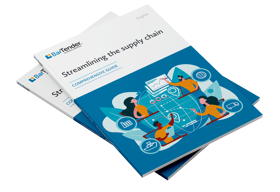Doing business in a global economy is becoming increasingly complex, introducing new challenges that small businesses and enterprise organizations alike must tackle to remain successful and compliant. That’s not always an easy feat, especially with the growing number of new and updated regulations that organizations must adhere to.
Supply chain visibility, or the process of accurately tracking products as they move through the supply chain, is crucial in regulated industries. Each stakeholder, from the manufacturer to the customer, relies on the information on the label and barcode. For the numerous organizations who outsource aspects of their production, it’s even more important to maintain consistency as products move through the supply chain.
To effectively do that, enterprise organizations rely on barcode and labeling systems that seamlessly integrate with other processes and software to ensure that requirements are met, and accuracy is maintained, even as a company grows and regulatory standards change.
While the goal of a centralized label design and barcoding process is clear, what exactly does barcoding software do? And how do you know if your software is effective?
In this chapter, we’ll break it down to the basics of what barcode and label design software does, how it works and the numerous benefits of choosing a labeling software that works for you and your stakeholders.
What is a data carrier and why are they important?
When people think of barcodes, they may be most familiar with barcodes used on grocery items, but their usefulness extends far beyond the supermarket and has grown over the past few decades.
Numerous organizations from pharmaceutical and medical device companies, to aerospace and retailers rely on barcoding technology to streamline the process of barcode label making, printing and tracking to ensure compliance, safety, security, and efficiency at every point in their supply chain. With present day barcoding software, organizations and their stakeholders can track every single product, device or component down to granular detail.
Furthermore, the advancement of automated barcode and label design software has eliminated the need for manually entering data for each barcode and allows barcoding technology to easily integrate with existing business processes and software, like warehouse management systems (WMS), Oracle and SAP.
Barcodes are one of the technologies that make up automatic identification and data capture (AIDC or Auto-ID), which expedites the process of data collection and communication to improve performance, productivity, efficiency, compliance and consumer safety. A barcode can contain a vast amount of information including:
- Part numbers
- Manufacturer ID
- Transaction codes
- Location codes
- Expiration dates
- Prices
- Personal information
- Product type
- Lot number
Barcode and label design software offers intelligent systems that manage the complexities of creating and automating labels for a variety of industries, including:
- Food and beverage
- Medical device
- Pharmaceutical
- Aerospace
- Retail
- Supply chain
Barcodes for regulated industries
Regulated industries rely heavily on barcodes and label design software to help monitor regulatory compliance by centrally managing traceability and serialization required by industry regulations. It also helps ensure the safe and accurate transmission of products through the supply chain, offering enterprise organizations barcode solutions even when they operate in multiple locations around the world.
A comprehensive barcoding system is able to adapt to changing standards in a variety of industries, delivering information to different users in a safe, efficient and useful way. The following regulations and standards are commonly addressed by barcode and label design software:
- GS1 Digital Link: Standard for web-enabled 2D barcodes (data carriers) that deliver quick, accurate information to users.
- GHS: Globally Harmonized System of Classification and Labelling of Chemicals to communicate health and safety information on labels.
- UDI: Unique Device Identifier to identify and track medical devices sold in the United States to improve safety, device innovation and efficiency. RFID is often used to help track medical devices according to UDI regulations.
- FDA 21 CFR Part 11/GMP Annex 11: Both regulate electronic documentation and electronic signatures in medical device and pharmaceutical industries. FDA regulates in the U.S. and GMP in Europe.
- EU FIC: Food Information to Consumers, which delivers allergen information to consumers to enhance safety and transparency for consumers.
- ATA SPEC 2000: International standard to improve communication and efficacy across the aviation supply chain.
An example of how barcoding and regulatory guidelines coalesce is evident in the way hospitals manage medical devices. Using a barcoding system for inventory like RFID, medical devices are monitored to identify what the item is, where it’s located (asset tracking or Real Time Location Strategy), its age, updates needed and more. Integrated barcoding software works with other automated systems, such as an ordering system, to ensure that the hospital has the supplies and devices it needs, which helps eliminate human error and keep hospitals accountable for their equipment.
In other industries, barcodes are used to track inventory, assist with accounting, monitor sales trends, provide verification (airplane ticket or ID) or aid with effective advertising campaigns using QR codes.
How barcode and label design software and business processes intersect
These days, barcode and label design are a fully integrated part of many small and large organizations. Barcode and label design software support the creation of digital twins using RFID tags and labels that make an exact, digital replica of all information that is on the object itself, then integrate that with other business processes and software that are required to transmit necessary data. Thus, each system needs to seamlessly integrate with the other to ensure the accurate use of information.
For enterprise businesses that operate on a global scale, the pace of business lends to constant changes. Without the ability to pivot when there are changes in the supply chain, productivity can slow dramatically, and inaccuracies can occur. Enterprise labeling needs to account for factors like language, location, regulations and product changes, but to do so effectively it also needs to work with existing systems such as:
- Enterprise Resource Planning (ERP)
- Warehouse Management Systems (WMS)
- Operating systems, web browsers and devices
- Various brands of printers in multiple locations
- Databases
- Human resources
- Financial
- Scales
With these integrations, organizations will see improvement in:
- Compliance
- Efficiency
- Safety
- Security
- Supply chain visibility
- Standardization
When organizations try to meet their needs with other solutions like using third parties or developing their own internal processes, they’re likely to experience inefficiencies or mistakes that don’t allow them to continue growing. While these solutions may seem cost-effective at the beginning, they can end up being expensive later, necessitating a more robust label design software to improve productivity. With barcode and labeling software for enterprise businesses, many of these mistakes can be avoided.
Similarly, barcode and labeling software for small business is just as important as it is for enterprise businesses. Smaller organizations that operate in regulated industries are subject to the same guidelines and need to be prepared.
Additionally, small businesses may not have the time and resources to manage their inventory and warehouses in the same way as a large organization. Tools like barcode inventory software can help streamline processes so that even with fewer resources, small organizations can be successful and grow.
Label design and the global supply chain
The supply chain is a complex network of suppliers, manufacturers, contractors, logistics providers and more. Some of these stakeholders may be a part of your organization, while many may be third parties that are more difficult to manage and regulate, especially on a global scale.
An enterprise labeling software ensures that labeling processes remain consistent no matter who is involved. With the demand for efficiency at an all-time high, virtual modeling of the physical supply chain via a digital twin helps reflect the state of every moving piece. An item can be tracked throughout the supply chain, making the supply chain more efficient and improving velocity and interoperability. This ensures that data is updated in real time for a part of, or a whole supply chain. The benefits of this system include:
- Identifying bottlenecks in the supply chain
- Understanding supply chain efficiency and dynamics
- Developing and updating supply chain
- Inventory management
- Compliance across supply chain
- Accuracy
Of course, with these benefits, organizations can also prevent costly errors that may result in relabeling.
The ability to connect multiple stakeholders allows for all organizations to effectively grow and still meet customer demands or consider entering a new market or geographic location with ease.
Learn more about effective labeling solutions
Enterprise barcode and labeling solutions really are essential for many organizations. They allow for the efficient tracking of numerous products at every point in the supply chain, anywhere in the world. Every supplier and every facility can draw from the same centralized labeling system to ensure data is accurate, up to date and compliant.
When choosing a labeling software, you need a solution that can do it all, and scale with your growing business. With BarTender® software, organizations of all sizes can create, automate and manage labeling to maintain security and safety.
Contact us to learn more about our products and be sure to continue reading our guide on how to streamline your supply chain with simple, effective labeling solutions.


